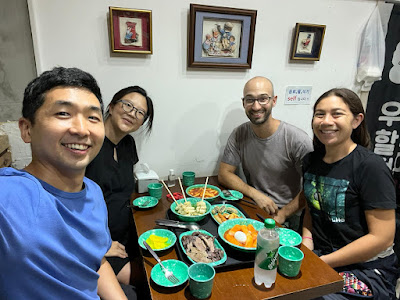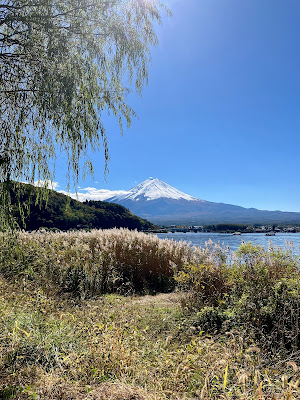What We've Been Eating
The most popular content among our readers has always been the food we're eating. We appreciate your tolerance as we write about less interesting topics, like museums, what we've learned, and our "thoughts." So without any clever remarks or preamble, here's what you're all waiting waiting for.
Tteok-bokki
Here's a much nicer photo of tteok-bokki that we didn't take
and copied from this blog: https://iamafoodblog.com/tteokbokki/
Tteok-bokki is a glutinous rice cake that is stewed or fried in a sweet and spicy gochujang sauce. Although it may look like penne pasta in the photo, it is a solid cylinder of rice cake has a delightfully chewy texture. It is also a ubiquitous street snack. Our friends Sean and Chloe took us to a sit-down tteok-bokki restaurant for one of our first meals in Korea- but more commonly it's sold to eat on the go.
Chi-mek: Fried Chicken and Beer
Another Korean staple! We met Sean and Chloe at the most popular chi-mek spot in their neighborhood. One thing we're learning: portions in Korea are often very large. When we got down to the last few pieces of chicken, we were so full we had to make a pact that we would all eat at least one more piece to finish it off.
Makgeolli
Makgeolli is a sparkling rice wine with a nice fruity flavor. We picked up a bottle at a convenience store and it's pretty good! Matt nursed his 750 mL bottle over three evenings, but we have frequently seen locals sitting down for a meal and each drinking their own in one sitting among friends. Considering it is about 7% alcohol, that's quite impressive!
Ginseng Chicken Soup
This large ginseng chicken soup restaurant churns out so much soup, we saw a waiter carrying buckets of chicken bones out to the trash. They wanted us to buy one soup per person, but ultimately relented and allowed us to share. Good thing too, because the soup contained a lot of chicken. In Matt's opinion, the real hero of the meal was the raw garlic kimchi. The fermentation process must have removed all the harsher flavors, leaving only a crunchy clove of slightly sweet and spicy garlicky goodness. Between the two of us, we probably had 30 cloves of kimchi garlic!
We've noticed that a lot of Korean restaurants give you the tools to season your food yourself. The soup was a good example- it gives the was practically unsalted, and we added salt on our own.
Traditional Tea and Sweets
This teahouse in an old-timey wooden "Hanok" house was a nice place to wait out some rain. Karen ordered a traditional "five flavor" Omija iced "tea" (really a juice made from magnolia berries) and Matt had a fermented yellow tea- the favorite tea of the man who took our order. We enjoyed our tea alongside mochi and a Korean dessert called yugwa, which had an amazing ginger flavor and light consistency. We didn't realize it at the time, but having had some more yugwa since then, we now know it was exceptionally light and crispy.
We were given a crash course in how to prepare our tea: fill the little teapot halfway; cover and let steep for 30 seconds (no more! no less!); pour through the metal strainer into the larger pitcher; then serve into the main glass cup, and the wooden sharing cup. It was fun to use all the little accoutrements and be mindful of the tea making process.
The "omija" tea was served in a teacup that was more like a bowl.
The Yugwa desert cookies are shown on the right.
A close-up of Yugwa
Notable Fruits
Korea is known for a large varietal of green muscat grape. They also grow an equally large purple grape which tastes similar to a concord. The skin pops off so easily, people tend to suck out the fruit and toss the relatively bitter skin. These grapes reminded Karen of how her Mom used to painstakingly peel grapes so that she would eat them as a little kid. I wish this had been around since they are sooooo easy to peel.
We also bought some oriental melons for breakfast. That's not us being lazy- they are actually called oriental melons, and they are closely related to cucumbers and taste similar to cantaloupe. They're fine.
Naengmyeon
Naengmyeon is a cold noodle soup, and a personal favorite of Karen's! Although the photo makes it looks pretty simple, the flavors are so interesting and good! The clear broth is made from beef and the water from Korean radish kimchi. It is both salty and sweet and refreshingly cold! The soup was served with starchy/chewy noodles, cucumber, beef, hardboiled egg and radish. On the side, we had radish kimchi and a hot/salty beverage.












Comments
Post a Comment